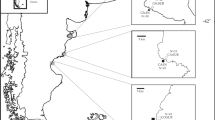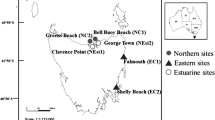Abstract
Variations of shell form and shell length were studied for oysters growing in the mangroves of Gazi Creek, Kenya, and related to different environmental factors.
For the study of the form, Fourier analysis was performed on the circumference of 85 oysters. The resulting coefficients were compared among specimens using cluster analysis. The correspondence between this classification and substrate diameter is virtually perfect (only one misclassification out of 85 oysters). For the clusters based on height above chart datum, 9 specimens, all on intermediate height levels, were misclassified. Orientation with respect to tidal current had 13 misclassifications. Mangrove species seemed to influence form only marginally, if at all.
In the study of the size ofCrassostrea cucullata, the length of 956 oysters, growing along two transects were measured, and correlated with several environmental factors. Oyster length was not related to substrate diameter or its orientation with respect to the main current. Length was not influenced by density up to a cover of 70%. For densities higher than 70%, there was a fairly strong negative correlation (r 2 = 0.634,n = 217). Length was not correlated with height above bottom (base of the tree) for heights lower than 20 cm, while oysters growing closer to the bottom were smaller. The correlation with height above chart datum was negative but very low (r 2 = 0.060,n = 957). However, if all measurements of oysters closer than 20 cm to the bottom, and all from a density of more than 70% cover are deleted from the data set, the correlation with height increased dramatically, the slope still being negative (r 2 = 0.859,n = 543).
Similar content being viewed by others
References
Anstey, R. L. & D. A. Delmet, 1972. Genetic meaning of zooecial chamber shapes. Science 177: 1000–1002.
Anstey, R. L. & D. A. Delmet, 1973. Fourier analysis of zooecial shapes in fossil tubular bryozoans. Geol. Soc. Am. Bull. 84: 1753–1764.
Chelazzi, G. & M. Vannini, 1980. Zonation of intertidal molluscs on rocky shores of southern Somali. Estuar. coast. mar. Sci. 10: 569–583.
Christopher, R. A. & J. A. Waters, 1974. Fourier series as a quantitative descriptor of miospore shape. J. Paleontol. 48: 697–709.
Comfort, A., 1946.Patella vulgata L. relation of habitat to form. J. Conch. 22: 216–217.
Day, J. H., 1974. A guide to marine life of South African shores. Balkema. Cape Town, 300 pp.
Ebling, F. J., J. F. Sloane & H. M. Davies, 1962. The ecology of Lough Ine. XII. The distribution and characteristics ofPatella species. J. anim. Ecol. 31: 457–470.
Ehrlich, R. & B. Weinberg, 1970. An exact method for characterisation of grain shape. J. Sed. Petrol. 40: 205–212.
Everitt, B. S., 1977. The analysis of contingency tables. Chapman and Hall. London, 128 pp.
Ferson, S., F. J. Rohlf & R. K. Koehn, 1985. Measuring shape variation of twodimensional outlines. Syst. Zool. 34: 59–68.
Gallin, E., E. Coppejans & H. Beeckman, 1989. The mangrove vegetation of Gazi Bay (Kenya). Bull. r. Soc. Belg. 122: 197–207.
Hartnoll, R. G., 1976. The ecology of some rocky shores in tropical East Africa. Estuar. coast. mar. Sci. 4: 1–21.
Healy-Williams, N. & D. F. Williams, 1981. Fourier analysis of test shape of planktonic foraminifera. Nature 289: 485–487.
Kaesler, R. L. & J. A. Waters, 1972. Fourier analysis of the ostracode margin. Geol. Soc. Am. Bull. 83: 1169–1178.
Kesteven, G. L., 1941. The biology and cultivation of oysters in Australia. I. Some economic aspects. Commonwealth of Australia. Melbourne, 32 pp.
Kuhl, F. P. & C. R. Giardini, 1982. Elliptic Fourier features of a closed contour. Computer Graphics and Image Processing 18: 236–258.
Lewis, J. R., 1964. The ecology of rocky shores. Hodder & Stoughton, London, 323 pp.
Okemwa, E. R., R. K. Ruwa & P. Polk, 1986. The autecology of the edible oysterCrassostrea cucullata Born, 1778: size-related vertical distribution at Mkomani, Mombasa. Kenya J. Sci. Ser. B 7: 9–14.
Ricker, W. E., 1973. Linear regressions in fishery research. J. Fish. Res. Bd Can. 30: 409–434.
Ruwa, R. K., 1984. Invertebrate faunal zonation on rocky shores around Mombasa, Kenya. Kenya J. Sci. Ser. B 5: 49–65.
Ruwa, R. K. & W. H. Brakel, 1981. Tidal periodicity and size-related variations in the zonation of the gastropodNerita plicata on East African rocky shore. Kenya J. Sci. Ser. B 2: 61–67.
Tack, J. F., 1990. Ecomorfologie van de mangroveoesterCrassostrea cucullata (Born, 1778). Unpublished M. Sc. thesis, Free university of Brussels, 99 pp.
Taylor, J. D., 1968. Coral reef associated invertebrate communities (mainly molluscan) around Mahe, Seychelles. Phil. Trans. r. Soc., Lond. Ser. B 254: 129–206.
Taylor, J. D., 1970. Intertidal zonation at Aldabra atoll. Phil. Trans. r. Soc., Lond. Ser. B 260: 173–213.
Trevaillon, A., R. R. C. Edwards & J. H. Steel, 1970. Dynamics of a benthic bivalve. In J. H. Steel (ed.), Marine Food Chains, University of California Press, Los Angeles: 285–295.
Van Someren, V. D. & J. P. Whitehead, 1961. An investigation of the biology and culture of an East African oyster,Crassostrea cucullata. Col. Off. Fish. Pub. 14: 1–36.
Vermeij, G. J., 1972. Intraspecific shore-level size gradients in intertidal molluscs. Ecology 53: 693–700.
Vermeij, G. J., 1973. Morphological patterns in high intertidal gastropods: adaptive strategies and their limitations. Mar. Biol. 20: 319–346.
Ward, J. H., 1963. Hierarchical grouping to optimise an objective function. J. am. Stat. Ass. 58: 236–244.
Ward, J. H. & M. E. Hook, 1963. Application of an hierarchical grouping procedure to a problem of grouping profiles. Educational and Psychological Measurement 23: 69–81.
Younker, J. L. & R. Ehrlich, 1977.Fourier biometrics: harmonic amplitudes as multivariate shape descriptors. Syst. Zool. 26: 336–342.
Author information
Authors and Affiliations
Rights and permissions
About this article
Cite this article
Tack, J.F., Vanden Berghe, E. & Polk, P. Ecomorphology ofCrassostrea cucullata (Born, 1778) (Ostreidae) in a mangrove creek (Gazi, Kenya). Hydrobiologia 247, 109–117 (1992). https://doi.org/10.1007/BF00008209
Issue Date:
DOI: https://doi.org/10.1007/BF00008209




